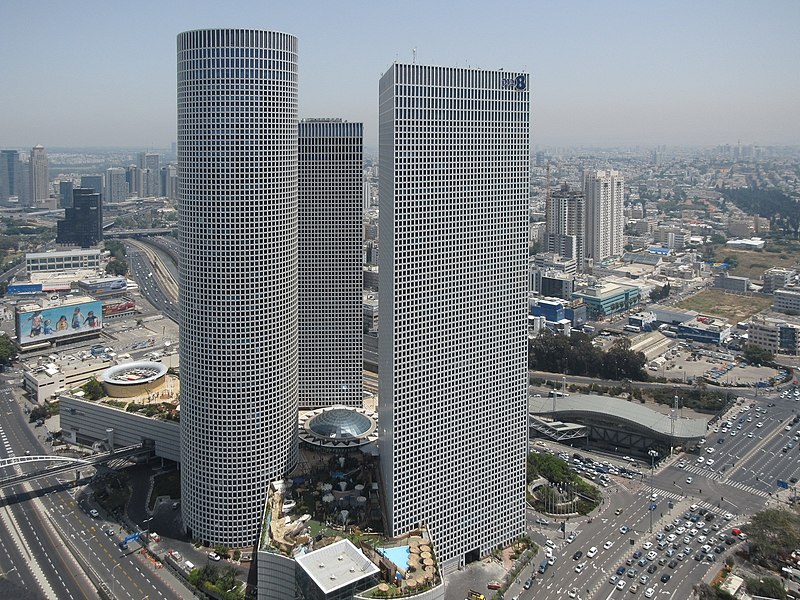Coming back to our series "Top 10 Cities in the Middle East", what I suggest for today is a new interesting and appealing cultural expedition in order to discover another top attraction in the Middle Eastern region: also known as "The White City" as it boasts the world's largest collection of International-style buildings, the financial and business capital of Israel is renowned for its unique architecture and development within the last century. Nowadays, Tel Aviv holds a certain appeal towards tourists from all over the globe - let's find out why it deserves being ranked among the most important cities in the Middle East, in today's article!
With an estimated population of 410000 people and an urban area of 52 km2 , Tel Aviv is the second most populous city in Israel, after the capital, Jerusalem. The city is located on the Israeli Mediterranean Coastline, in central-western Israel, in the largest metropolitan area in the country, Gush Dan. Tel Aviv has the second largest economy in the Middle East, after Dubai and the 5th most visited city in the Middle East and Africa.
Tel Aviv is a quite recent urban center, being founded in 20th April 1909, on the outskirts of the ancient port Jaffa (the two merged into a single municipality in 1950, two years after establishment of the state of Israel). The name of the new city was adopted in 21st May 1910, while it was granted municipal status in 1934. Although the city was many times affected by the military conflicts and lots of old constructions from the ancient Jaffa were demolished to make room for the modern ones, the overall aspect of Tel Aviv shows up a complex architectural evolution, a wide range of styles being adopted in a relatively short period of time. The most remarkable of them are the Eclectic style, specific to the 1920s and the International style inspired by Bauhaus and Le Corbusier, in the 1930s.


The Eclectic Orientalist style combines European architecture with Eastern features such as arches, domes and ornamental tiles.

The International style was implemented by the Jewish architects who lived in Germany and studied in the Bauhaus School for Art and Design, who immigrated to Israel during 1930s, bringing about major changes of approach towards the local architecture. In 2003 the city of Tel Aviv became of the UNESCO World Cultural
Heritage site, owing to over 4,000 Bauhaus buildings which are spread
over the city.
Tel Aviv is a multicultural city, with a great cultural and ethnical diversity. It is divided into nine districts that have formed naturally over the city's short history.

Azrieli Center is a complex of skyscrapers in Tel Aviv.
The Azrieli Center Circular Tower is the tallest of the three
towers, measuring 187 m in height. Construction of this tower
began in 1996 and was completed in 1999. The tower has 49 floors, making
it the tallest building in Tel Aviv and the second tallest in Israel, after the Moshe Aviv Tower in Ramat Gan built in 2001.
The Azrieli Center Triangular Tower has a height of 169 m. Construction of this tower, like the circular tower, began in
1996 and was completed in 1999.
The Azrieli Center Square Tower was completed in June 2007. The tower has 42 floors, and is 154m high. It is the shortest of the
three towers in the Azrieli complex.
Shalom Meir Tower is an office tower in Tel Aviv. It was Israel's first skyscraper. When its construction was completed in 1965, it rivaled the tallest buildings in Europe in height, and was the tallest in the Middle East.

Ramat Aviv is a district situated in the northern part of the city that is largely made up of luxury apartments and includes Tel Aviv University.

Neve Tzedek is a neighborhood located in southwestern Tel Aviv. It was the first Jewish neighborhood to be built outside the walls of the ancient port of Jaffa. Since the early 1980s, Neve Tzedek has become one of Tel Aviv's
latest fashionable and expensive districts, with a village-like
atmosphere and various architectural styles, as seen in the picture above.
Nehoshtan Tower is a skyscraper located near the Neve Tzedek district of the city. It is the eleventh tallest building in the country
at 147 meters in height and over 44 floors. The tower contains 300
apartments and was completed in 2007. The
tower was designed by Gabai Architecture & Building.

Florentin is a neighbourhood in the southern part of Tel Aviv, often associated with a bohemian lifestyle due to the large number of coffeehouses, markets, bars, galleries and parties. Since the 1980s the municipality invested large sums of money in restauration projects for the southern part of the city.
Boasting such a wide range of architectural styles, Tel Aviv would be an excellent source of inspiration for any architecture lover. Since the architectural evolution goes on, the innovative character of this sprawling city is definitely something worth taking into consideration and placing it among the greatest Middle Eastern cities.
Resources:



Das Problem ist, dass man so viele unterschiedliche Meinungen findet und
ReplyDeletees dann schwerlich ist, einen objektiven Überblick zu haben.
Ich muss sagen, ich bin beeindruckt. Sie haben in Ihrem Text den Nagel auf
den Kopf getroffen. Ich bin froh, diesen Artikel gelesen zu haben.
Also visit my web page ... Homepage mit Joomla erstellen
Danke schön. Ich bin froh, dass Sie meinen Artikel nützlich gefunden haben!!
ReplyDeletegreat really I'm so happy and read it carefully thanks for sharing it's own best list blog site
ReplyDeletewe are providing the best quality and perfect apartments provide you can rent for live
Luxury Apartments in Tel Aviv
Tel Aviv Properties Management
Buy apartment in Israe